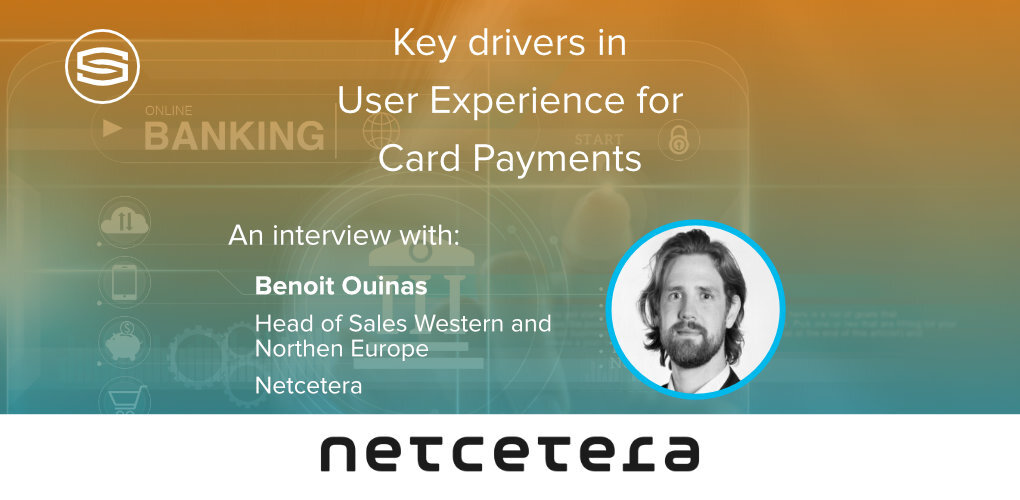
Insights & Opinions
Key drivers in User Experience for Card Payments
Mon, 27 Mar 2023


One of our corporate members is Netcetera, a global software company with cutting-edge IT products and individual digital solutions in the areas of secure digital payment, financial technologies, publishing, transport, healthcare and insurance. More than 2,500 banks and issuers, and 160,000 merchants rely on the digital payment solutions and globally certified 3-D Secure products of the market leader for payment security.
We spoke to their Head of Sales Western and Nothern Europe, Benoit Ouinas, about the latest trends in user experience in the card payments process, with talking points like tokenisation, Click-to-Pay and delegated authentication.
Hello, Benoit. Please tell us who Netcetera is and what your contributions are to the banking industry.
Benoit Ouinas: Netcera is a 26-year-old Swiss software development company, mainly present in Switzerland, Germany and Austria. The company always had a strong focus on securing and allowing online payments. Since day one, the financial services industry and banks have been our main clients.
Over the past five years, we expanded internationally to support banks, merchants, payment providers and institutions to overcome the technical challenges they face today in securing their payments processes.
How we contribute is also true if I say we help in the digitalisation of the banking industry. We are a proven and reliable digital partner that helps banks leverage the benefits of using digital channels and services in a seamless and secure way as if they would happen in the physical world.
Looking into Digital Banking as a whole ecosystem of opportunities to collaborate, innovate and deliver value for our customers, we are embracing all the payment trends such as Click-to-Pay, embedded finance, raising awareness of and having environment-friendly solutions, finding use cases on how to monetise data are only to name a few. We help our customers always have the competitive edge they need in this dynamic market.
Here I can take as an example our own white-label mobile wallet solution that banks leverage for their direct connection with the customers and not lose ownership of this relationship to other industry players like the bigtech wallet providers.
It is really nothing new, but I can’t emphasise enough how important it is to have the customer always in focus when designing and creating a digital banking service and delivering the best customer experience. Knowing who the customers are, what their needs are, and which channels they use or prefer, as it is quite obvious that not all customers are the same, and offering services tailored to their needs makes a big difference.
Take, for example, the mobile banking app used by seniors or teenagers. Would you agree that the expectations they have are not the same? This is why we have this expertise in-house and help banks meet and exceed customer expectations.
To sum up, I would say having a competitive and attractive portfolio of customer-facing digital services is what banks should focus on providing today to ensure customer satisfaction and business in the future.
Card payments are one of the main drivers of your business. However, should we still be talking about card payments or refer to card-enabled digital payments instead?
Benoit Ouinas: That’s an excellent question. I think, indeed, card payments are maybe a bit too narrow. After all, the card is only a factor of authentication today, and you can have a card number that could refer to either a physical or a digital card. So it’s way broader than just payments with a card. I think we will continue to speak about this physical factor even when it doesn’t exist anymore, in a world where we use pure virtual cards online, for example.
So I agree that it’s broader, but let’s simplify for everyone and continue to call it card payments, maybe.
Correct. Click-to-Pay is one of the solutions to build more convenient and yet more secure transactions with cards. How does Click-to-Pay change the user experience in e-commerce?
Benoit Ouinas: The numbers vary from country to country, but in some countries, we witnessed 46% of buyers are stopping and abandoning their shopping baskets. That is because, at some point, it is required to log in or create an account and to enter all personal details, not only card details but also address and so on.
Click-to-Pay is one proposition today created by international card schemes to enhance what we call the guest checkout experience in e-commerce.
We talked a lot with PSD2 about card payment and the friction linked to strong customer authentication. But we tend to forget that massive abandonment happens before the payment takes place. The idea of Click-to-Pay is to provide an experience with a card payment that is as smooth as the experience you can have with Apple Pay or PayPal online, for example.
With just one click, these solutions allow you to share all your addresses, delivery address, billing address, and payment details that you entered at some point. That way, you actually smoothen the checkout process.
We think it’s extremely interesting, not so much for the large merchants that will keep a very close relationship and have merchant wallets. But more for small and medium-sized merchants where you purchase something, for example, once every five years. And you don’t need to enter all this information.
These consumers mainly shop on very large marketplaces, and with Click-to-Pay, you can also allow smaller e-commerce shops a convenient and differentiated payment experience.
Behind Click-to-Pay, the information is tokenised, so no card details, like the PAN, are being shared at any moment. At the same time, you respect the PSD2 strong authentication process.
So next to the security element, it’s also a matter of improving privacy. Is that correct?
Benoit Ouinas: Yes, you could say that, indeed. With this solution, you no longer share an account number that is being stored at every step of the process at the bank or the card scheme. This means that merchants don’t have your card data anymore. That is a very powerful value proposition.
Obviously, you still exchange data like the address. But now, you act in a completely secured PCI-certified environment in terms of managing your payment data and even your billing and invoicing.
Who is in the lead to implement the solution? Is it the issuer or, rather, the acquirer?
Benoit Ouinas: That’s a tricky question. Acquirers/PSPs/merchants are autonomous in this implementation. Technically, they don’t need the issuers to be onboarded.
However, we firmly believe that the adoption of Click-to-Pay will accelerate with the issuers adopting it. For one reason, because it improves the payment experience, we also see in most European countries that the trust is in our issuers and banks. And having the backing of those banks will help to stimulate the trust and usage of this new technology and support further growth.
One last question: what do you consider the next steps in bringing UX in payments to new levels?
Benoit Ouinas: We believe that a lot of technologies are already present and not implemented yet. We had PSD2, and we see some countries just recovering from the cumbersome implementation of two-factor authentication.
The exemptions allowed by PSD2 are in some countries not yet implemented. Some others have just started thinking about very nice exemptions that are whitelisting merchants or investigating the opportunities of delegated authentication.
Delegated authentication is the idea that in the user experience, you don’t leave the merchant application or the merchant environment anymore for authentication in the payments process. But you still do a fingerprint and strong authentication at the beginning of the process.
All this is already technically possible. But marketing teams must digest all the changes from the last five years before taking the next steps. So if we can implement all those elements today, we will reach a next-level, very smooth user experience already.
I believe that managing all those implementations will take some time. This, to me, is the next step in bringing UX in payments to new levels: properly implementing what already exists today.